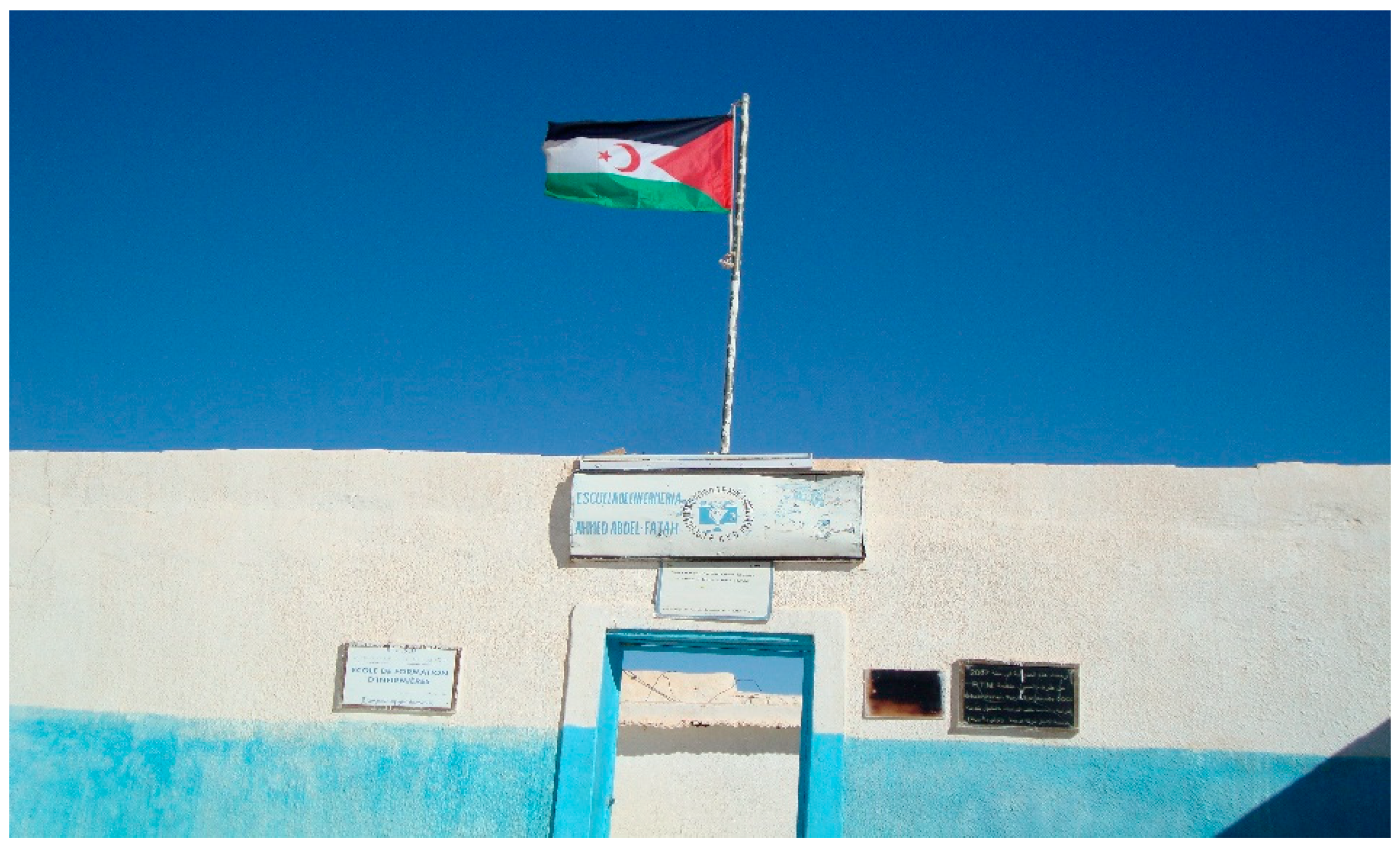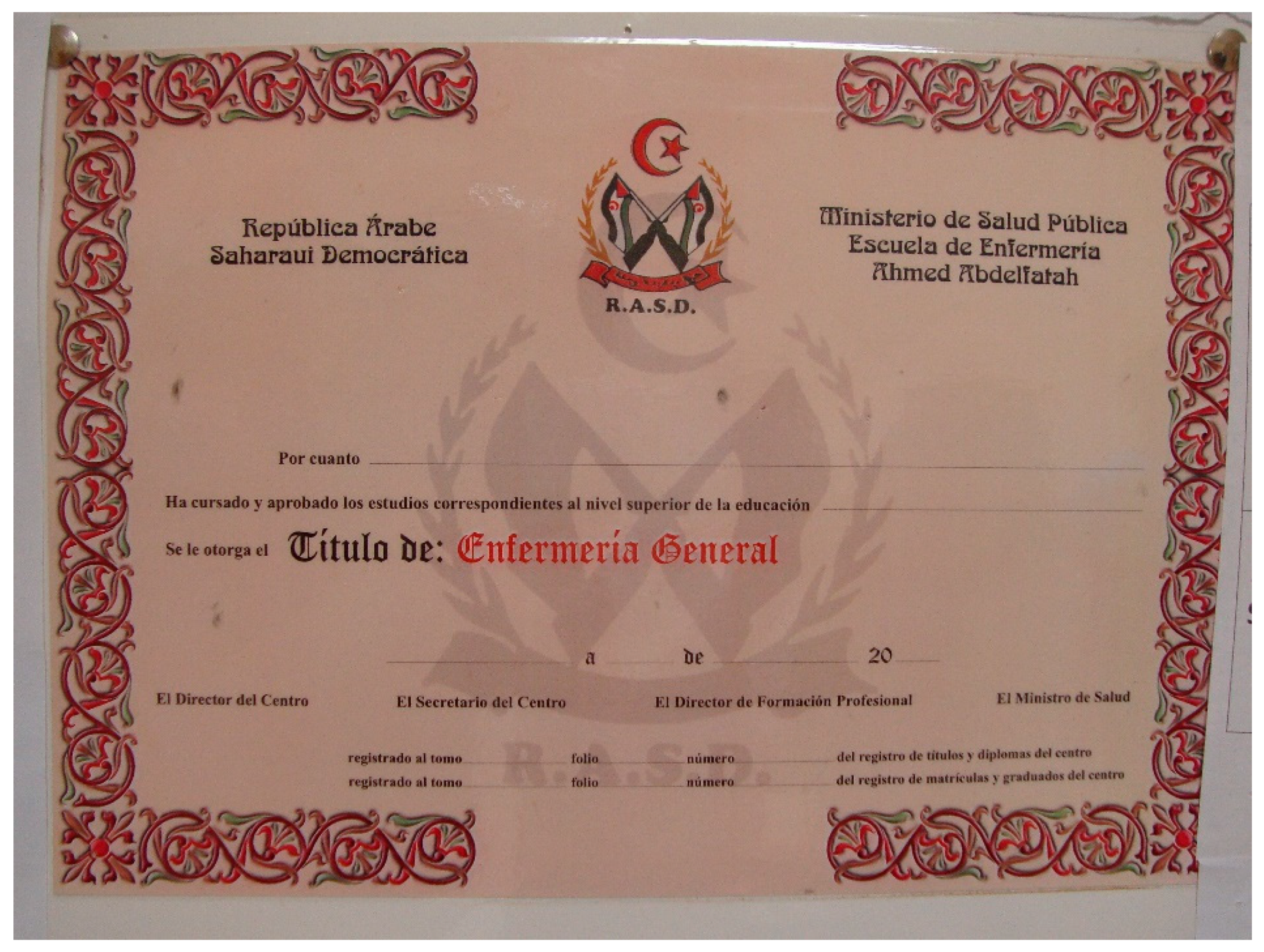Is It Possible to Become a Nurse in a Refugee Camp?
Abstract
:1. Introduction
2. Literature Review
3. Material and Methods
4. Results
4.1. Geopolitical and Economic Context of the Sahrawi Refugee Camps
4.2. Education in the Sahrawi Camps
4.3. Ahmed Abdel-Fatah National School of Nursing: Past, Present, and Support from International Cooperation
4.4. Current Academic Curriculum of the Nursing School
4.5. Undergraduates and Graduates of the Nursing School, 1992–2018
4.6. What Has Been Reached and What Is yet to Come
- Collaborating in the improvement of health services through the support of qualified staff.
- Allowing for the admission of more students after the school’s expansion.
- Preparing textbooks and teaching models according to the needs and resources at hand.
- Improving the training and teaching of students.
- Offering retraining and further education in practical and theoretical skills, for both teachers and students.
- -
- Seeking funding for future training courses, such as Nursing Administration and Management, Emergency Nursing and retraining for graduates.
- -
- Coordinating with cooperation agents to ensure the pedagogical training of the school’s teachers.
- -
- Consistently guaranteeing better living conditions for students and teachers, as well as electrical and Internet supply during training periods.
- -
- To construct a building for the Pediatric Nursing specialty.
5. Discussion
6. Conclusions
Author Contributions
Funding
Conflicts of Interest
References
- Hernández, A. Territorio, historia e identidad: Sus El Aksa ó Sáhara Occidental. REIM 2010, 9, 1–10. [Google Scholar]
- González, L. Ocupación del Sáhara Occidental: Un conflicto pendiente y una sociedad en espera. In El Otro en la Arena: 20 Miradas y un Parpadeo al Sáhara Occidental; Mercadillo, R.E., Mulay, A., Eds.; Gedisa: Barcelona, Spain, 2015; pp. 61–74. [Google Scholar]
- Gómez, C. Saharauis, una migración circular entre España y los campamentos de refugiados de Tinduf. In Mediterráneo Migrante: Tres Décadas de Flujos Migratorios; de Castro, C., Ed.; Universidad de Murcia: Murcia, Spain, 2010; pp. 29–45. [Google Scholar]
- Proyecto: Mantenimiento Básico de la Escuela de Enfermería Ahmed Abdel-Fatah (Basic Maintenance Project at the Abdel-Fatah School of Nursing). Available online: http://saharavillena.org/portfolio-item/proyecto-2015/ (accessed on 15 March 2019).
- United Nations Maps. Available online: https://www.un.org/Depts/Cartographic/map/dpko/minurso.pdf (accessed on 13 September 2019).
- Martínez-Linares, J.M.; Linares-Abad, M.; Calero-García, M.J.; López-Entrambasaguas, O.M. Is it possible to become a midwife in a refugee camp? Midwifery 2019, 75, 12–15. [Google Scholar] [CrossRef] [PubMed]
- Estrategia Humanitaria de Contexto: Población Refugiada Saharaui 2018–2019. Available online: http://www.aecid.es/CentroDocumentacion/Documentos/Acci%C3%B3n%20Humanitaria/180309_estrategia_Humanitaria_REFUGIADA_SAHARAUI.pdf (accessed on 26 May 2019).
- University of Jaén. Proyecto Contribución a la mejora de la calidad de vida de la población saharaui (Project to contribute to the improvement of the quality of life of the Sahrawi population). Unpublished.
- Ruiz, J. La tierra de los hombres azules. Colonización del Sáhara: 1860–1967. Historia 1979, 16, 58–71. [Google Scholar]
- United Nations. Declaration on the Granting of Independence to Colonial Countries and Peoples. Resolution 1514 (XV) of United Nation General Assembly on 14 December 1960. Available online: https://www.un.org/es/decolonization/declaration.shtml (accessed on 12 August 2019).
- Mera, A. El Sáhara Occidental: Un Conflicto Olvidado; Institut de Drets Humans de Catalunya: Barcelona, Spain, 2006; pp. 5–10. [Google Scholar]
- Trasosmontes, V. The Sahrawi refugee camps in Tindouf: An economic analysis. REM 2011, 29, 285–315. [Google Scholar]
- United Nations High Commissioner for Refugees. Refugiados Saharauis: 40 Años de Vida en los Campos. Available online: https://eacnur.org/blog/refugiados-saharauis-40-anos-de-vida-en-los-campos/ (accessed on 12 August 2019).
- United Nations High Commissioner for Refugees. Pueblo Saharaui: Situación Actual y Perspectivas de Futuro. Available online: https://eacnur.org/blog/pueblo-saharaui-situacion-actual-y-perspectivas-de-futuro/ (accessed on 12 August 2019).
- Enfants Réfugiés du Monde Auprès des Sahraouis. Available online: https://www.ouest-france.fr/pays-de-la-loire/reze-44400/enfants-refugies-du-monde-aupres-des-sahraouis-2676889 (accessed on 4 September 2019).
- Vitoria-Gasteiz Coopera en la Educación, Sanidad y Derechos Humanos del Pueblo Saharaui. Available online: https://blogs.vitoria-gasteiz.org/medios/tag/asociacion-de-amigas-y-amigos-de-la-rasd/ (accessed on 4 September 2019).
- Proyecto 2015. Available online: http://saharavillena.org/portfolio-item/proyecto-2015/ (accessed on 4 September 2019).
- Coordinación del Refuerzo al Hospital Nacional de Rabuni y a la Escuela de Enfermería de los Campamentos de Personas Refugiadas del Sáhara. Available online: http://sector3.net/ficha_oferta.php?id=1471 (accessed on 4 September 2019).
- Alianza Sáhara Salud. Available online: https://alumni.uam.es/colabora/accion_solidaria/alianza-sahara-salud (accessed on 4 September 2019).
- La Universidad de Jaén Desarrolla en los Campamentos Saharauis de Tindouf un Proyecto Para Contribuir a la Mejora de la Calidad de Vida de su Población. Available online: https://diariodigital.ujaen.es/investigacion/la-universidad-de-jaen-desarrolla-en-los-campamentos-saharauis-de-tindouf-un-proyecto (accessed on 4 September 2019).
- University of Jaén. Informe de la Escuela de Enfermería Ahmed Abdel-Fatah de los Campamentos de Refugiados Saharauis en Smara. Unpublished.
- Aranda, R.; Arias, S. La formación del profesorado saharaui en los campamentos de refugiados de Tindouf (Argelia). Tend. Pedag. 2012, 20, 139–159. [Google Scholar]
- Calero-García, M.J.; Cruz-Lendínez, A. La mejora de la salud de la población saharaui a través de la innovación docente en la educación: Un proyecto de formación en cascada. Index Enfermería 2016, 25, 198–202. [Google Scholar]
- Ministry of Public Health, SADR. Ahmed Abdel-Fatah School of Nursing Report. Unpublished.
- Ministry of Public Health, SADR. Nursing Degree. Academic Curriculum. Unpublished.
- United Nations High Commissioner for Refugees. Datos Básicos. Anuarios Estadísticos. Available online: https://www.acnur.org/datos-basicos.html (accessed on 13 August 2019).
- United Nations High Commissioner for Refugees. Left behind Refugee Education in Crisis. Available online: https://www.unhcr.org/59b696f44.pdf (accessed on 13 August 2019).
- University of Tifariti RASD. Tifariti University Strategic Plan 2016–2020. Available online: http://www.universidadtifariti.org/wp-content/uploads/2018/05/03-revista-plan-estrategico-TIFARITI-INGLES.pdf (accessed on 13 August 2019).
- United Nations High Commissioner for Refugees. ¿Cuáles son las Características de los Campos de Refugiados? Available online: https://eacnur.org/blog/cuales-son-las-caracteristicas-de-un-campo-de-refugiados/ (accessed on 13 August 2019).





| Interview Code | Post | Sex | Age | Experience (Years) | Nationality |
|---|---|---|---|---|---|
| I1 | Head | Male | 68 | 36 | Sahrawi |
| I2 | Professor | Male | 28 | 5 | Sahrawi |
| I3 | Professor | Female | 25 | 2 | Sahrawi |
| I4 | Professor | Female | 42 | 19 | Sahrawi |
| I5 | Professor | Female | 26 | 2 | Sahrawi |
| I6 | Professor | Male | 35 | 13 | Sahrawi |
| I7 | Professor | Male | 34 | 10 | Sahrawi |
| I8 | Head of studies | Male | 56 | 24 | Sahrawi |
| I9 | Secretary | Female | 58 | 21 | Sahrawi |
| NGDO/Association | Funding Body | Action Undertaken |
|---|---|---|
| Enfants Refugiés du Monde [14] | United Nations High Commission for Refugees City of Rezë City Hall of Pays de la Loire | Improving the school’s infrastructure Theoretical and practical training |
| Asociación de Amigos y Amigas del Pueblo Saharaui de Vitoria (Friends of the Sahrawi People Association of Vitoria, Spain) [15] | Council of Vitoria City Hall of Vitoria | Improving the school’s infrastructure Theoretical and practical training |
| Asociación DAJLA de Amigos y Amigas del Pueblo Saharaui de Alicante (DAJLA Friends of the Sahrawi People Association of Alicante) [16] | City Hall of San Vicente University of Alicante | Improving the school’s infrastructure Theoretical and practical training |
| Doctors of the World (Spain) [17] | Spanish International Development Cooperation Agency | Improving the school’s infrastructure |
| Asociación Alianza Sáhara-Salud (Sahara Health Alliance Association, Spain) [18] | Autonomous University of Madrid | Theoretical and practical training for Nursing Consultants |
| University of Jaén [19] | University of Jaén Andalusian International Development Cooperation Agency | Improving pedagogical performance |
| Class | Enrolled | Graduates |
|---|---|---|
| 1992–1995 | 32 | 07 |
| 1995–1998 | 45 | 17 |
| 1996–1999 | 31 | 08 |
| 1997–2000 | 25 | 12 |
| 1998–2001 | 30 | 15 |
| 1999–2002 | 26 | 09 |
| 2000–2003 | 32 | 13 |
| 2001–2004 | 35 | 11 |
| 2002–2005 | 29 | 15 |
| 2003–2006 | 35 | 13 |
| 2004–2007 | 37 | 13 |
| 2005–2008 | 35 | 15 |
| 2006–2009 | 38 | 14 |
| 2007–2010 | 40 | 19 |
| 2008–2011 | 32 | 10 |
| 2009–2012 | 38 | 14 |
| 2010–2013 | 35 | 09 |
| 2011–2014 | 31 | 18 |
| 2012–2015 | 35 | 17 |
| 2013–2016 | 44 | 16 |
| 2014–2017 | 45 | 17 |
| 2015–2018 | 42 | 19 |
| Total | 737 | 301 |
© 2019 by the authors. Licensee MDPI, Basel, Switzerland. This article is an open access article distributed under the terms and conditions of the Creative Commons Attribution (CC BY) license (http://creativecommons.org/licenses/by/4.0/).
Share and Cite
López-Entrambasaguas, O.M.; Martínez-Linares, J.M.; Linares-Abad, M.; Calero-García, M.J. Is It Possible to Become a Nurse in a Refugee Camp? Int. J. Environ. Res. Public Health 2019, 16, 3414. https://doi.org/10.3390/ijerph16183414
López-Entrambasaguas OM, Martínez-Linares JM, Linares-Abad M, Calero-García MJ. Is It Possible to Become a Nurse in a Refugee Camp? International Journal of Environmental Research and Public Health. 2019; 16(18):3414. https://doi.org/10.3390/ijerph16183414
Chicago/Turabian StyleLópez-Entrambasaguas, Olga María, Jose Manuel Martínez-Linares, Manuel Linares-Abad, and María José Calero-García. 2019. "Is It Possible to Become a Nurse in a Refugee Camp?" International Journal of Environmental Research and Public Health 16, no. 18: 3414. https://doi.org/10.3390/ijerph16183414
APA StyleLópez-Entrambasaguas, O. M., Martínez-Linares, J. M., Linares-Abad, M., & Calero-García, M. J. (2019). Is It Possible to Become a Nurse in a Refugee Camp? International Journal of Environmental Research and Public Health, 16(18), 3414. https://doi.org/10.3390/ijerph16183414





